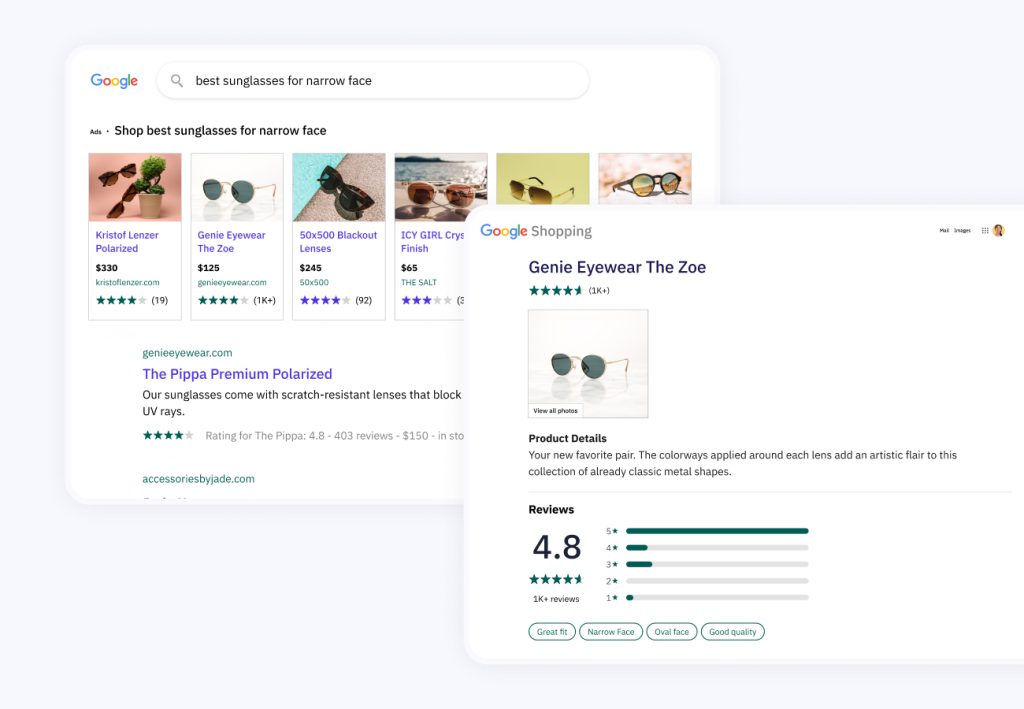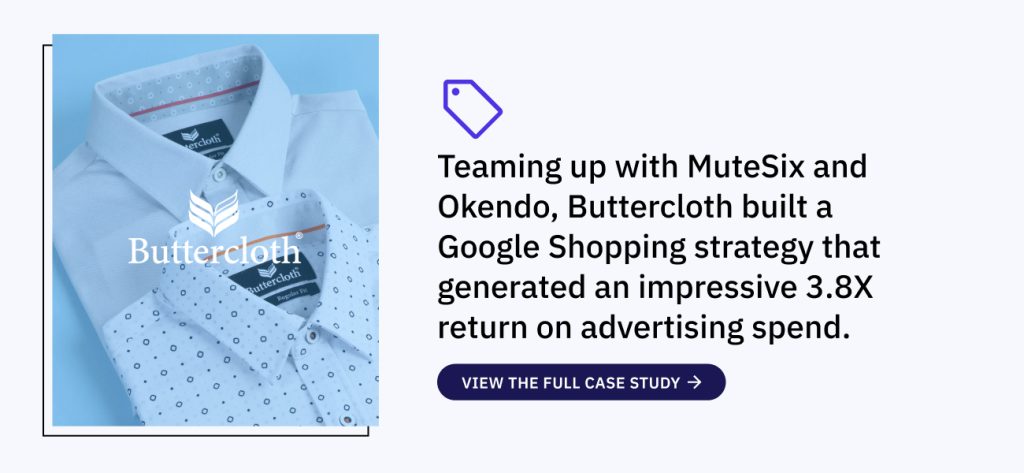
- Ecommerce Marketing
- Reviews and UGC
What is Testimonial Advertising? Types, Benefits & Examples
Megan Wenzl | Jun 26, 2024
Nov 21, 2022 | 11 minute read

Lindsay Kolinsky
Director of Marketing
Google Shopping has become a force for consumers and ecommerce brands alike in recent years. Two decades after its launch as “Froogle”, a service that enabled buyers to compare products and prices, the platform has evolved into one of the most effective sales tools for retailers and a facilitator of one of the most convenient consumer buying experiences.
Today, thousands of Direct-to-Consumer (DTC) brands use the search giant’s shopping tool to connect consumers with their products, taking advantage of its simple and accessible functionalities and features to boost sales and build brand credibility. In fact, Google announced in 2021 that in the past year, it saw an 80% growth in the number of merchants using Shopping and a 70% increase in products listed on the platform.
Clearly, the ongoing ecommerce boom is driving interest in Google Shopping. But the truth is, as consumer demands intensify, Google Shopping is giving retailers access to the tools and features they need to attract a new generation of buyers. This generation is increasingly putting a premium on social proof, seeking to build trust with a brand before doing business with them, and expecting instant access to the products they want, when they want them.
That’s what this article is all about. We’ll share all you’ll need to harness the power of Google Shopping and walk you through how Okendo can strengthen your strategy and help take your ecommerce business to the next level.
Most DTC marketers will tell you the same thing regarding Google Shopping: it’s one of the most versatile platforms. It’s a service that has gone through numerous iterations since its foundation in the early 2000s, proving Alphabet’s commitment to customers and merchants worldwide and its ability to adapt and adjust to their ever-changing needs. For example, it recently announced a series of updates to Search aimed at tackling clickbait and improving the relevancy of search results that directly impacted Shopping. Now, unoriginal, low-quality content doesn’t rank as highly.
Meanwhile, after announcing last year that it would sunset Smart Shopping and Local campaigns, Google rolled out a tool to allow advertisers to self-upgrade to Performance Max. The features help them reach more shoppers across all Google Ads channels, including YouTube, Search, and Discover.
At Google Shopping’s core, however, is simplicity. Consumers begin by inputting the product they are looking for into the search bar, and then they arrive at an easy-to-navigate page with side-by-side comparisons of the most relevant results. They can use filters like color, brand, price, and others to find exactly what they want. When they discover products of interest, they can bring up pictures, descriptions, and price options with a click.

Ecommerce is the dominant force in the shopping world. 63% of shoppers begin their journeys online, and 80% of online shoppers think that new technologies will improve their shopping experience, from helping them discover new products to making comparisons easier.
As consumers continue to prioritize convenience and personalization when researching and buying products online, Google Shopping has become a one-stop shop for them – and a highly effective avenue for merchants to increase visibility, clicks, and sales through both paid and organic channels.
Google Shopping Ads, in particular, are highly effective at bringing more qualified traffic to your website and reaching more people. In fact, they are significantly more effective than Search ads for retailers, giving them a much higher chance of their ads being seen. This is because a Google Shopping Ad appears first in the searches in a carousel for up to twenty ad positions, compared to just two search ad positions for the advertiser in mobile search.
Moreover, Google Shopping Ads feature product images, making them more visually appealing and far more effective in helping consumers find what they are looking for – or serendipitously discover on their shopping journey. Indeed, Google Shopping Ads have become a sought-after way to cost-effectively boost traffic to your website, generate new leads, and increase conversions.
In fact, a recent Merkle report found that Google Shopping’s click share of Google search ad clicks hit an all-time high of 63%. Meanwhile, separate research from Wordstream shows campaigns that use Google Shopping ads have a significantly lower CPC – $0.66 compared to $1-$2 of ordinary search ads. As a result, Shopping campaigns save you money while still increasing traffic to your store.
Smart Shopping Campaigns are like the 2.0 version of regular digital ad buys. They’re more precise, have better conversion rates, and, as the name indicates—are smarter.
Unlike standard Google Shopping campaigns, which are more time-consuming for merchants to stand up and manage, Smart Shopping Campaigns have speedy setups and are fully automated, saving you and your team hours in the long run. After setup, Google takes the parameters and guidelines you’ve given it and uses their algorithm to place your ad in front of the right person at the right time.
Google’s ad bidding model makes this happen, meaning that instead of explicitly choosing the sites that ads will appear on, Google places them at each moment an opportunity comes (more on that later).
For example, let’s say you’re running a boutique apparel line and want more clicks on the new washed boyfriend-cut jeans you offer. You know the style did best with women between the ages of 20 and 30 that lived close to major metropolitan areas. Therefore, you would set those parameters in Google to get the product in front of people whose profiles fit that targeted demographic.
All it takes to start is a Google Ads account and an active Merchant Center account with up-to-date product data and a link between your Merchant Center and Google Ads accounts.
Google knows you’re busy. That’s why they’ve made Smart Shopping campaigns low-input, high-return endeavors. Once set up, it instantly generates optimized ads from your business’ product feed.
Optimized bidding runs automatically from there. Every time Google has open ad space, it instantly auctions it off to the merchant whose ad fits the criteria best. The key for businesses is then setting the correct parameters to win the space you’re looking for based on the metrics that suit you best—clicks, views, signups, or otherwise.
And like your business, Google is constantly striving for improvement, meaning that the Shopping app only gets better with time. Nick Brown, Head of Digital Performance at No Standing, agrees, “Improving the offering of Smart Shopping Campaigns is clearly a key focus for Google. Recent integrations with Shopify and GoDaddy, coupled with extended and new features, which will be exclusive to the campaign type, all back this theory up.”
But like every online marketing operation, the Google Shopping bidding process has pros and cons: the algorithm places your ads in front of highly motivated buyers in your demographic, but you might not always know where and when they’re going to show up. But it all comes out in the wash—conversions are progressively getting easier to achieve, and overall results are constantly improving.
Five stars is the universal language for one thing: an excellent product. When it comes to impacting campaign performance and conversions, the power that comes with social proof through reviews and ratings is undeniable.
Whether a five-star rating or a killer review, social proof works for consumers in the same way that you are more likely to buy a specific product after your friends rave about it. High star ratings mean a business is trustworthy, and you don’t have to worry about spending your money with them. And today, trust is the new ecommerce currency.
Great reviews build credibility and trust, showing that customers loved the product so much that they went out of their way to tell others. They are the rocket fuel powering the most highly impactful Google Shopping campaigns.
The data backs it up. Recent data shows that 80% of consumers feel that trust is a deciding factor in their buying decisions, and 90% make a point to read the reviews before buying a product. Suppose your business and product is the one with the endorsement frenzy in the review section. In that case, shoppers already showing a higher purchase intent after actively entering a search term are clicking through armed with more information and positive preconceptions.
Social proof also gets more important as price points get higher. If a consumer holds your more expensive product side-by-side with lesser expensive ones, and yours has strong rankings and stellar reviews, it becomes easier to justify the higher price tag. The same logic applies in hyper-competitive markets like fashion, where an excellent rating almost always boosts you over your closest rival in a one-on-one comparison.
Thinking about how many reviews your product gets is just as important as how good the reviews are—that’s where Okendo shines. Using its automated request flow and high review cadence to drive increased customer reviews, most Okendo clients get a review rate that sets them apart from their competition. This almost always means that the Okendo client’s product is the one that gets added to the shopping cart.
Of course, merchants know that high ratings and many reviews will drive great results on Google shopping. What most merchants don’t know, however, is how to do it effectively. That’s where Okendo comes in. Alex Bauer, Power Digital’s Director of Business Development and Strategic Partnerships, recently said:
“It’s never been more important for e-commerce merchants to have a Google Shopping strategy that enables your e-commerce store to be visible to millions of shoppers and helps drive qualified traffic.
A Google-Certified Partner like Power Digital can help you set up your Google Shopping account and show you how adding authentic reviews by using a tool like Okendo can have a massive impact on your performance. The increased visibility and relevancy that come with reviews help your product stand out and have a massive impact on ad performance in Google Shopping.”
The platform will allow you to submit reviews by yourself through the Merchant Center. Savvy merchants will bring a results aggregator like Okendo onto their team to do it for them, which gets reviews up faster, drives them at a higher rate, and allows you to focus on the other parts of your business that need attention. This proactive approach to Google Shopping fast-tracks reviews of your products and is a powerful way to increase visibility, boost conversions and differentiate your brand.
Buttercloth is a premier example of the success that follows a savvy Google Smart Shopping campaign. Teaming up with MuteSix and Okendo, the luxury men’s shirt company built a Google Shopping strategy that generated a 52% uplift in spending, a 50% increase in revenue, a 62% leap in conversion rate, and an impressive 3.8X return on advertising spend (ROAS).

The strategy took a two-pronged approach to supercharge their Google Shopping campaigns. It:
Leveraging Buttercloth’s longest-running Google Smart Shopping Campaign, MuteSix accessed the hyper-accurate conversion data and paired it with social proof from Okendo, building a perfectly honed campaign to reach the right customers with the right products. Its success clarifies that enhanced visibility gives people the confidence to invest in high-quality apparel at a higher price point.
If you’re interested in deploying Google Smart Shopping campaigns and leveraging social proof to get better numbers, here are our top three tips for success.
The key to success is leveraging Google’s Smart Shopping campaigns and high-impact social proof, pulled from a reliable, impactful platform like Okendo.
Have you been looking for ways to boost your e-commerce presence? Or reach the full potential of your Google Shopping profile?
When you team up with Okendo, you get access to a platform that taps into the most powerful functions of Google Shopping. Time and again, our social proof and Smart Shopping strategies drive better reviews and higher conversion rates for clients, while also building trust and stronger reputations. If that’s something that your business wants to take advantage of, we’re always here to help.
Related articles
Ready to learn more?